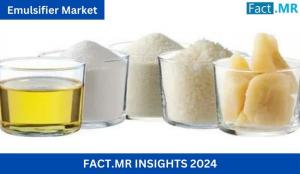Emulsifier Market to Expand at 5.3% CAGR, Reaching $6.27 Billion by 2034
Extensive incorporation of emulsifiers in personal care products such as lotions and shampoos to mix different chemicals useful for the skin, says Fact.MR.
ROCKVILLE, MD, UNITED STATES, May 31, 2024 /EINPresswire.com/ -- Fact.MR’s latest industry research report states the global emulsifier market is estimated to reach a valuation of US$ 3.74 billion in 2024 and advance at a CAGR of 5.3% from 2024 to 2034.Emulsifiers facilitate the blending of two liquids. Emulsifiers help impart smooth textures and extend the shelf life of foods such as mayonnaise, ice cream, chocolates, and creamy sauces. Emulsifiers play a vital role in preventing the separation of oil and water in certain foods. Emulsifiers are extensively used in the chemical industry to combine immiscible substances. Emulsions help improve drug administration by enhancing absorption, taste, and texture, leading pharmaceutical companies to seek quality emulsifiers for formulations.
Get Free Sample Copy of This Report:
https://www.factmr.com/connectus/sample?flag=S&rep_id=10158
Plant-derived emulsifiers are becoming increasingly popular due to the growing demand for organic products. Improved spreadability of emulsifiers in skincare products is beneficial for cosmetic industry players, leading to increased incorporation of emulsifiers in skincare formulations.
Key Takeaways from Market Study
The global emulsifier market is projected to reach a valuation of $6.27 billion by 2034. North America is anticipated to hold a 24.3% share of this market by the end of the forecast period. In East Asia, the market is expected to expand at a compound annual growth rate (CAGR) of 5.6% from 2024 to 2034, reflecting robust growth in the region. Similarly, Mexico's emulsifier market is forecasted to grow at a CAGR of 4.5% over the same period, indicating significant regional development.
Japan is set to play a major role in the East Asian emulsifier market, projected to occupy 29.4% of the market share by 2034. On the product front, lecithins are estimated to account for 21.8% of the emulsifier market share in 2024, underscoring their importance in the industry. These trends highlight the dynamic growth and regional variances within the global emulsifier market, driven by diverse applications and increasing demand across different geographies.
“Non-toxic nature of emulsifiers is making them safe for use in food products, fueling a steady increase in emulsifier sales within the food industry. Fluctuations in commodity prices, especially for agricultural goods like palm oil, soybeans, and sunflowers, are driving up operational costs for emulsifier producers,” says a Fact.MR analyst.
Extensive Use of Anionic and Nonionic Emulsifiers in Metalworking Fluids to Enhance Lubrication Properties
Metalworking fluids and other industrial lubricants are generally oil/water emulsions. Emulsifiers enable metalworkers to benefit from both the lubricating powers of oils and the cooling capabilities of water. Anionic and nonionic emulsifiers are frequently combined in metalworking fluids. Cationic emulsifiers are not as frequently employed because they are unstable in alkaline solutions (pH 8-9.5), which are essential for metalworking fluids.
Country-wise Insights
The emulsifier industry’s competitive landscape is marked by key players focusing on innovation and significant investments in R&D to secure a competitive edge. Strategies such as regional expansion, mergers, and acquisitions are prominent as companies adapt to market trends, including the production of emulsifier enhancers, clean-label emulsifiers, and plant-based alternatives.
For instance, in September 2021, Corbion launched Pristine 3000, a revolutionary dough conditioner in its Pristine range, designed to help bakers manage challenges like wheat protein inconsistencies and high-speed processing without relying on traditional treatments like diacetyl tartaric acid ester of monoglycerides (DATEM) or gluten supplements. Similarly, in September 2020, Cargill’s Brazilian branch established a new factory to produce pectin, a versatile fruit byproduct used in various food items as an emulsifier. These developments highlight the industry's commitment to advancing technology and meeting evolving consumer demands.
Get Customization on this Report for Specific Research Solutions:
https://www.factmr.com/connectus/sample?flag=RC&rep_id=10158
Explore More Related Studies Published by Fact.MR Research:
Plant-based Emulsifiers Market: The global plant-based emulsifiers market was valued at US$ 1.21 billion in 2022, with worldwide demand for plant-based emulsifiers accelerating at a CAGR of 7.6% from 2018 to 2022. The global market is forecasted to expand at 7.2% CAGR and reach US$ 2.60 billion by 2033-end.
Natural Food Color Additive Market: The global natural food color additive market is valued at US$ 1.7 billion in 2023 and is projected to expand at a CAGR of 7.2% to reach a size of US$ 3.41 billion by the end of 2033.
About Fact.MR:
We are a trusted research partner of 80% of fortune 1000 companies across the globe. We are consistently growing in the field of market research with more than 1000 reports published every year. The dedicated team of 400-plus analysts and consultants is committed to achieving the utmost level of our client’s satisfaction.
Contact:
US Sales Office
11140 Rockville Pike
Suite 400
Rockville, MD 20852
United States
Tel: +1 (628) 251-1583, +353-1-4434-232 (D)
Sales Team: sales@factmr.com
S. N. Jha
Fact.MR
email us here
Visit us on social media:
X
LinkedIn
Other
Legal Disclaimer:
EIN Presswire provides this news content "as is" without warranty of any kind. We do not accept any responsibility or liability for the accuracy, content, images, videos, licenses, completeness, legality, or reliability of the information contained in this article. If you have any complaints or copyright issues related to this article, kindly contact the author above.

